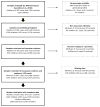Prenatal exposure to drinking-water chlorination by-products, cytochrome P450 gene polymorphisms and small-for-gestational-age neonates
- PMID: 28774688
- PMCID: PMC5677517
- DOI: 10.1016/j.reprotox.2017.07.019
Prenatal exposure to drinking-water chlorination by-products, cytochrome P450 gene polymorphisms and small-for-gestational-age neonates
Abstract
Genetic susceptibility may modulate chlorination by-products (CBPs) effects on fetal growth, especially genes coding for the cytochrome P450 involved in the metabolism of CBPs and steroidogenesis. In a case-control study of 1432 mother-child pairs, we assessed the association between maternal and child single nucleotide polymorphisms (SNPs) within CYP1A2, CYP2A6, CYP2D6 and CYP17A1 genes and small-for-gestational-age neonates (SGA<10th percentile) as well as interaction between these SNPs and maternal exposure to trihalomethanes or haloacetic acids (HAAs) during the third trimester of pregnancy. Interactions were found between mother and neonate carrying CYP17A1 rs4919687A and rs743572G alleles and maternal exposure to total trihalomethanes or five regulated HAAs species. However, these interactions became non statistically significant after correction for multiple testing. There is some evidence, albeit weak, of a potential effect modification of the association between CBPs and SGA by SNPs in CYP17A1 gene. Further studies are needed to validate these observations.
Keywords: CYP17A1; CYP1A2; CYP2A6; CYP2D6; Chlorination by-products; Gene-environment interaction; Intra-uterine growth restriction; Single nucleotide polymorphism; Small-for-gestational-age.
Copyright © 2017 Elsevier Inc. All rights reserved.
Conflict of interest statement
None declared.
Figures
Similar articles
-
Women exposure during pregnancy to haloacetaldehydes and haloacetonitriles in drinking water and risk of small-for-gestational-age neonate.Environ Res. 2015 Feb;137:338-48. doi: 10.1016/j.envres.2015.01.005. Epub 2015 Jan 17. Environ Res. 2015. PMID: 25601737
-
Maternal exposure to drinking-water chlorination by-products and small-for-gestational-age neonates.Epidemiology. 2012 Mar;23(2):267-76. doi: 10.1097/EDE.0b013e3182468569. Epidemiology. 2012. PMID: 22317810
-
Disinfection by-products exposure and intra-uterine growth restriction: Do genetic polymorphisms of CYP2E1or deletion of GSTM1 or GSTT1 modify the association?Environ Int. 2016 Jul-Aug;92-93:220-31. doi: 10.1016/j.envint.2016.03.033. Epub 2016 Apr 22. Environ Int. 2016. PMID: 27107227 Free PMC article.
-
Chlorination disinfection by-products in drinking water and congenital anomalies: review and meta-analyses.Environ Health Perspect. 2009 Oct;117(10):1486-93. doi: 10.1289/ehp.0900677. Epub 2009 Jun 15. Environ Health Perspect. 2009. PMID: 20019896 Free PMC article. Review.
-
Integrated disinfection by-products mixtures research: disinfection of drinking waters by chlorination and ozonation/postchlorination treatment scenarios.J Toxicol Environ Health A. 2008;71(17):1133-48. doi: 10.1080/15287390802182060. J Toxicol Environ Health A. 2008. PMID: 18636388 Review.
Cited by
-
Meta-analysis of small for gestational age births and disinfection byproduct exposures.Environ Res. 2021 May;196:110280. doi: 10.1016/j.envres.2020.110280. Epub 2020 Oct 6. Environ Res. 2021. PMID: 33035558 Free PMC article.
-
Risk factors for low birth weight in hospitals of North Wello zone, Ethiopia: A case-control study.PLoS One. 2019 Mar 20;14(3):e0213054. doi: 10.1371/journal.pone.0213054. eCollection 2019. PLoS One. 2019. PMID: 30893344 Free PMC article.
-
Gene-environment interactions related to maternal exposure to environmental and lifestyle-related chemicals during pregnancy and the resulting adverse fetal growth: a review.Environ Health Prev Med. 2022;27:24. doi: 10.1265/ehpm.21-00033. Environ Health Prev Med. 2022. PMID: 35675978 Free PMC article. Review.
References
-
- Allis JW, Anderson BP, Zhao G, Ross TM, Pegram RA. Evidence for the involvement of CYP1A2 in the metabolism of bromodichloromethane in rat liver. Toxicology. 2002;176(1–2):25–37. - PubMed
-
- Allis JW, Zhao G. Quantitative evaluation of bromodichloromethane metabolism by recombinant rat and human cytochrome P450s. Chem Biol Interact. 2002;140(2):137–153. - PubMed
-
- Backer LC, Ashley DL, Bonin MA, Cardinali FL, Kieszak SM, Wooten JV. Household exposures to drinking water disinfection by-products: whole blood trihalomethane levels. J Expo Anal Environ Epidemiol. 2000;10(4):321–326. - PubMed
Publication types
MeSH terms
Substances
Grants and funding
LinkOut - more resources
Full Text Sources
Other Literature Sources
Medical


